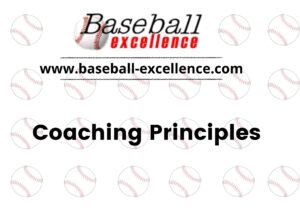OK your team has just taken the field for their defensive half of the inning. How do they use that time?
Do they walk onto the field or do they jog? Is the catcher in the dugout looking for his gear and does the pitcher have to warm up by throwing to the third baseman? Why can’t the right fielder find his glove? Why do these times in the game often look like a disorganized fire drill before every inning?
Let’s go over some things your team should be doing in order to get the most benefit from their defensive half of an inning.
Here is an all too typical youth baseball scene: The infielders walk, and sometimes it looks like they’re dragging, to their positions and the catcher is in the dugout getting his gear on.
The middle infielders are together on the grass taking ground balls from the first baseman and they are flipping them to him. They are flipping them to him because they are only about 20 feet away. And they are using poor fielding and throwing mechanics. They just bend over and let the ball roll into their gloves because the first baseman just rolls the balls to them.
The outfielders only get in one or two throws because of overthrows and missed balls and the fact they walked to their outfield positions and the fact that all three are playing catch together.
The catcher, after finally getting his gear on walks up to the plate, takes one pitch and the umpire suddenly calls “Balls in.” The catcher throws down to second and the ball sails into the outfield where the center fielder who is not paying attention lets it get by him.
The umpire says, “Play”. Are your players really ready to play?
A team can get in important and needed game-type repetitions if they will take this time in the game seriously. If they have a plan.
Here are some ways they can do it better and improve their pre-inning infield.
- All players should put their gloves in the same place in the dugout, every time. (the reason why in the next tip)
- When a player is left stranded on base his nearest position teammate should ‘pick him up.’ The means he should bring his teammate’s glove and/or cap with him onto the field so there will be no time wasted. How does he know where that glove is? Because everybody leaves their gloves in the same place in the dugout. (The nearest base coach can bring his batting helmet back to the dugout.)
- Everybody runs onto the field. Coaches have to reinforce this because the tendency in the late innings or when a team is behind in the score, is to drag a little bit. When do you most need your players to be alert and lively and ready? In the late innings.They have been sitting in the dugout so it is necessary for them to get the blood flowing. Jogging onto the field accomplishes that. It also looks like they came to play.What did Ralph Waldo Emerson say? “Nothing great was ever accomplished without enthusiasm.” (I have probably overused this but I believe it is one of the great motivational quotes, one that should be tacked on your son’s wall.)They don’t have to sprint to their positions. A brisk jog is fine.
- You must have a bullpen catcher. Let me say that again. You must have a bullpen catcher. When your starting catcher is left on the bases at the end of an inning your bullpen catcher must go to the plate to warm up your pitcher.If you have 12 players on your team then this is a reserve player. He should have his mask and glove ready so he can jog to the plate when all the other players take their positions.This will get your pitcher 5 or 6 extra pitches, ones he needs. I have heard it said, “No body else on this team can catch our pitcher.” Why not? Aren’t you working with both your catchers? Aren’t you giving your reserves and younger players something to do every inning? Aren’t you coaching all 12 players?
- A reserve player goes to the dugout-side outfield foul line and plays catch with that outfielder. This gives all outfielders more throws because the center fielder and off outfielder can warm up, just the two of them.It is important for them to work on throwing accuracy. They are not doing this so they can just toss the ball around. It should be done with a purpose.
- The other reserve player after he jogs in from the coaches box picks up all bats and equipment and puts it in its proper place.
- The infielders assume their deepest positions to take ground balls from the first baseman. The second baseman is in front of the outfield edge of the grass behind the bag, the short stop is on the outfield edge of the grass in the hole and the third baseman is as deep as he can get on the outfield edge of the grass.The toughest play they will have to make may be the farthest so why not have them work on that play in between innings? What does it accomplish to toss balls twenty feet?The first baseman should throw routine ground balls briskly to them and they should use good fielding mechanics and make accurate sharp throws back to him. They should jog back to their positions and await the next throw.All three infielders should make at least one backhand play every inning. The ball doesn’t have to be thrown perfectly to their backhand side; they can just wait on the ball and get into a backhand position.Every pre-inning infield should be taken seriously. It is very common to see infielders clowning around and throwing balls all over the place. Teach them how to do it correctly.Players left to their own devices will invariably do it wrong or with poor technique. They have to be taught and then receive reinforcement.
- The pitcher gets about 8 pitches during his warm-up. He should throw all his pitches, 4-seam, 2-seam fastballs and change up. If he has a breaking pitch he should throw at least one.On a regulation field he should throw the last two pitches from the stretch.
- A coach should pay close attention to his players during the time before every defensive half inning. He should be alert for lack of hustle and poor fielding technique.
It’s another one of those “Little Things that make a team better.”
I use verbal reinforcement at the end of every offensive half inning. You can use your own but these are some of the things I say; “Bullpen catcher get out there”, “Mike, pick up Tommy”, “First baseman do you have a ball?” (I usually make sure they get one when they come into the dugout after getting the third out.), “Stephen throw ‘em all” (Reminding the pitcher to warm up using all his pitches), “Good throws guys”, “Hustle, Chad.”
I’m sure they get tired of hearing me. I sound like a broken record but I refuse to let my players slack off even a little.
Poor pre-inning infield is as common as poor youth batting practice. Do your team a favor and get them ready to play. You will see a difference.




